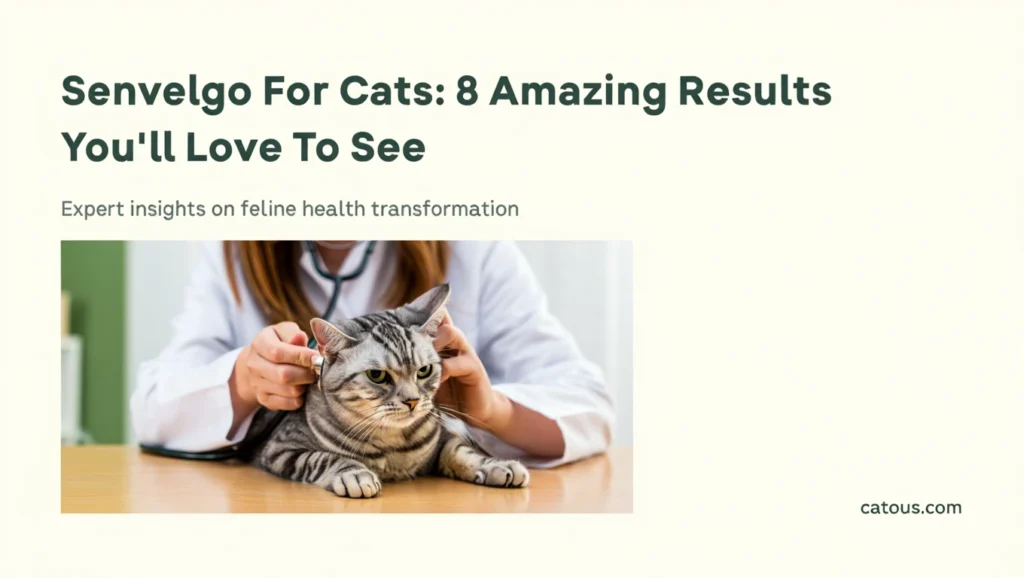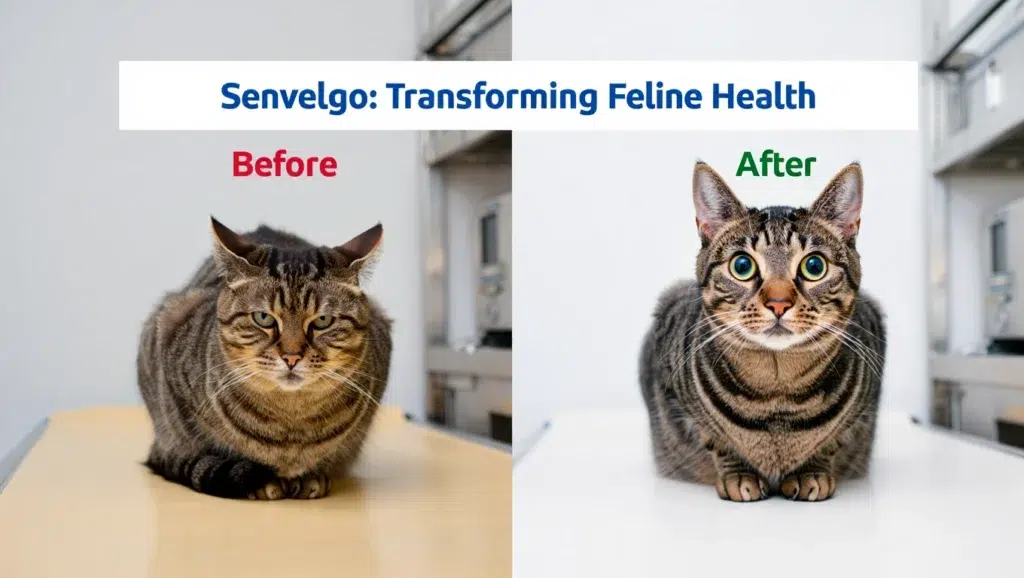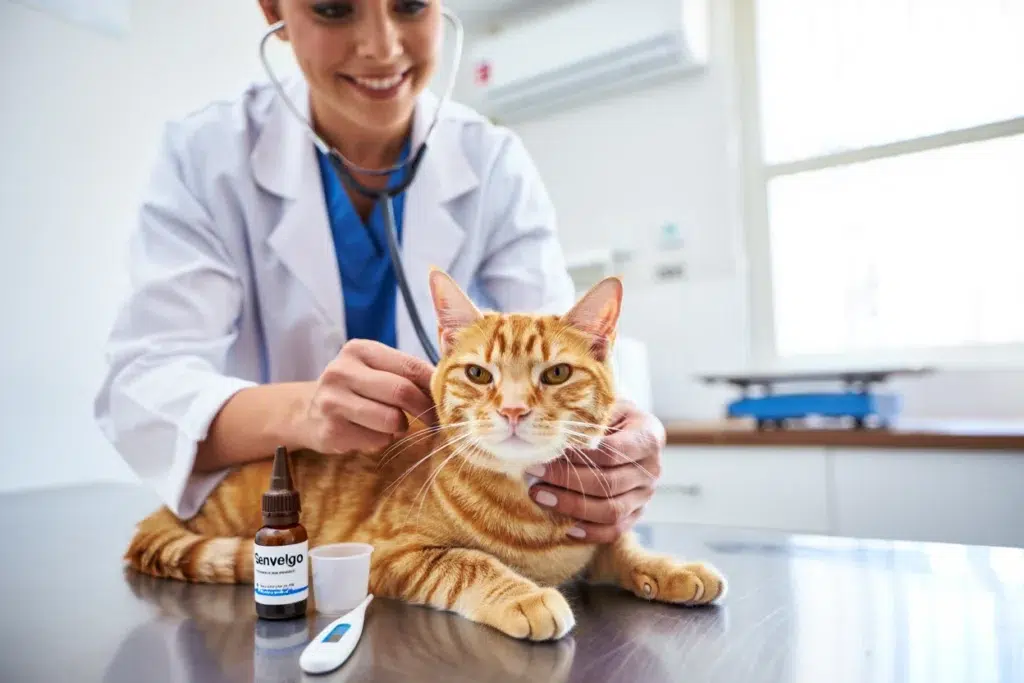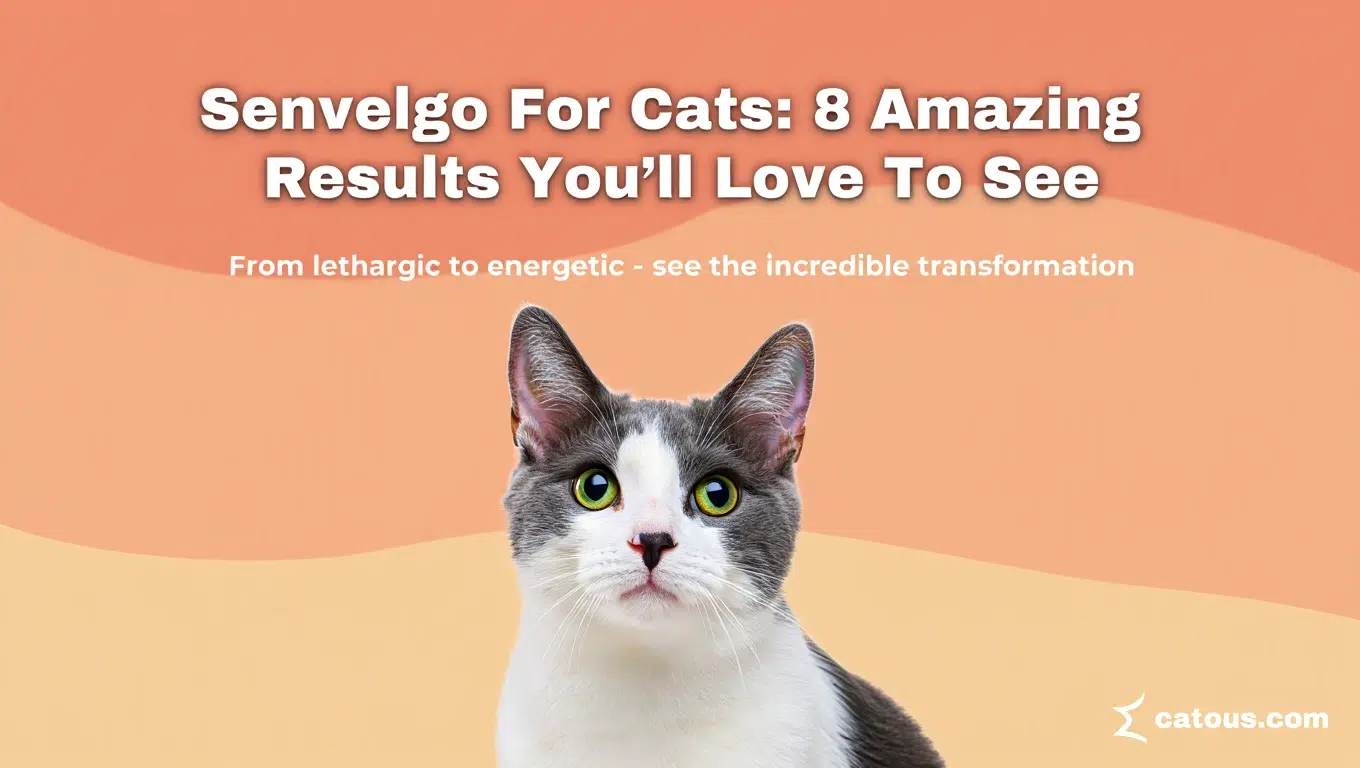Views: 0

Table of Contents
Introduction: A Game-Changer for Feline Diabetes
Is your diabetic cat struggling with daily insulin injections? You’re not alone. Many cat owners face the challenge of managing feline diabetes while worrying about their furry friend’s comfort and quality of life.

Senvelgo for Cats is revolutionizing diabetes treatment for our feline companions. This innovative oral solution offers hope to cats who haven’t been previously treated with insulin. Unlike traditional insulin injections that require precise timing and can stress both you and your cat, Senvelgo provides a simpler approach to blood sugar control.
Here’s an exciting fact: most cats achieve effective blood sugar control within just one week of starting treatment. This FDA-approved medication belongs to a class of drugs called SGLT2 inhibitors, which work differently than insulin by helping your cat’s kidneys remove excess glucose naturally.
In this comprehensive guide, we’ll explore eight amazing results you can expect when your cat starts Senvelgo treatment. From improved energy levels to easier medication routines, you’ll discover why this breakthrough treatment is making waves in feline healthcare. Ready to see what Senvelgo can do for your beloved pet?
What is Senvelgo for Cats?
Think of Senvelgo as your cat’s diabetes helper that works behind the scenes. But what exactly makes this medication so special?
Senvelgo (velagliflozin oral solution) is the first once-daily liquid oral treatment specifically designed to improve blood sugar control in otherwise healthy diabetic cats who haven’t previously received insulin therapy. Instead of forcing your cat to endure daily needle pokes, you simply give them a measured dose of this liquid medication once a day.
How does it work? Senvelgo takes a clever approach. It blocks certain proteins in your cat’s kidneys called sodium-glucose cotransporter 2 (SGLT2). When these proteins are blocked, excess glucose gets flushed out through urine instead of being reabsorbed into the bloodstream. Think of it as opening a drain to let out unwanted sugar from your cat’s system.
The best part? This medication carries a low risk of hypoglycemia (dangerously low blood sugar), which is a common concern with insulin injections. Plus, stabilized cats need less intensive monitoring compared to traditional insulin treatment.
Want to learn how Senvelgo could transform your diabetic cat’s daily routine? Keep reading to discover the eight amazing results that await.
Why You’ll Love Learning About Senvelgo for Cats
Understanding Senvelgo opens doors to better diabetes management for your feline friend. Here’s why this knowledge matters:
Improves Your Cat’s Daily Life: Managing diabetes becomes significantly easier when you don’t have to wrestle with syringes and strict injection schedules. Senvelgo fits naturally into your cat’s feeding routine, reducing stress for both of you. Your cat gets consistent blood sugar control without the anxiety that often comes with injections.
Cost-Effective Long-Term Solution: While initial costs may seem comparable to insulin, Senvelgo can save money over time. You’ll need fewer emergency vet visits related to blood sugar spikes or crashes. Less intensive monitoring means fewer glucose curves and veterinary appointments. Many pet insurance plans cover Senvelgo, making it more accessible than you might think.
Surprising Diabetes Insights: Did you know that cats often hide diabetes symptoms until the disease progresses? Early intervention with appropriate treatment like Senvelgo can prevent complications such as diabetic neuropathy (weakness in hind legs) and kidney problems. Understanding how SGLT2 inhibitors work gives you valuable insight into your cat’s overall health management strategy.
How to Administer Senvelgo for Cats
Quick Overview
Giving Senvelgo to your cat is refreshingly simple. The liquid formula eliminates the need for pills that cats often refuse or injections that create anxiety. Key benefits include:
- Once-daily dosing: No more multiple daily injections
- Flexible administration: Mix with food or give directly in the mouth
- Rapid results: Most cats show improvement within 7 days
- Well-tolerated: Cats generally accept the medication easily
- Minimal monitoring: Stabilized cats need less frequent blood checks
Key Steps for Administering Senvelgo
Step 1: Get Your Prescription Visit your veterinarian for a thorough diabetes evaluation. Your vet will confirm your cat meets the criteria (otherwise healthy, diabetic, not previously on insulin). They’ll prescribe the appropriate dosage based on your cat’s weight.
Step 2: Prepare the Medication Keep Senvelgo refrigerated between uses. Shake the bottle gently before each dose. Use the provided oral dosing syringe to measure the exact amount prescribed by your vet. Never guess or estimate the dose.
Step 3: Choose Your Administration Method You have two options. First, you can mix the medication with a small amount of wet food. Make sure your cat eats the entire portion to get the full dose. Second, you can place the medication directly into your cat’s mouth using the dosing syringe, aiming for the side of the mouth near the cheek.
Step 4: Establish a Routine Give Senvelgo at the same time each day to maintain consistency. Most owners find mealtime works best. Track doses on a calendar or phone app to avoid missing treatments.
Step 5: Monitor Your Cat’s Response Watch for increased thirst and urination (normal with this medication). Schedule follow-up vet appointments as recommended. Report any unusual symptoms like lethargy, vomiting, or loss of appetite immediately.
Step 6: Store Properly Always refrigerate the medication. Discard any unused solution after 28 days of opening. Keep the bottle tightly closed when not in use.
What to Pair With Senvelgo Treatment
Senvelgo works best as part of a comprehensive diabetes management plan. Consider these complementary approaches:
Diet Modifications: Feed your diabetic cat a high-protein, low-carbohydrate diet. Wet food generally works better than dry kibble for blood sugar control. Consider prescription diabetic cat foods formulated specifically for glucose management.
Weight Management: Maintaining a healthy weight is crucial. Overweight cats often have worse diabetes outcomes. Work with your vet to develop a gradual weight loss plan if needed.
Regular Exercise: Encourage play and physical activity. Interactive toys, laser pointers, and climbing structures help cats stay active. Exercise improves insulin sensitivity and helps regulate blood sugar.
Routine Veterinary Care: Schedule regular check-ups every 3-6 months. Monitor blood glucose levels as recommended by your vet. Watch for complications like urinary tract infections, which are more common in diabetic cats.
Related Resources:
- Learn about proper cat feeding schedules to optimize Senvelgo effectiveness
- Discover cat nutrition tips for diabetic management
- Explore signs your cat may be in pain to catch complications early
8 Amazing Results You’ll See With Senvelgo for Cats
Result #1: Rapid Blood Sugar Control
Most cats achieve effective glycemic control within the first week of treatment. Your vet will likely see improved glucose levels at the initial follow-up appointment. This quick response means your cat feels better faster.
Result #2: Increased Energy and Activity
As blood sugar stabilizes, you’ll notice your cat becoming more playful and energetic. They’ll show more interest in their favorite activities. The lethargy that often accompanies uncontrolled diabetes fades away.
Result #3: Reduced Excessive Drinking and Urination
One of the most noticeable improvements is decreased polydipsia (excessive thirst) and polyuria (excessive urination). While Senvelgo does increase urination as part of its mechanism, this stabilizes over time. Your cat will drink less frantically and use the litter box less frequently than when diabetes was uncontrolled.
Result #4: No More Stressful Injections
Say goodbye to the daily battle with syringes. The oral liquid formula eliminates injection-related stress for both you and your cat. Your relationship with your pet improves when medication time isn’t a struggle.
Result #5: Improved Appetite Regulation
Diabetic cats often experience abnormal hunger. As Senvelgo brings blood sugar under control, appetite normalizes. Your cat will eat appropriate amounts rather than constantly begging for food.
Result #6: Better Weight Management
Uncontrolled diabetes can cause weight loss despite increased appetite. With Senvelgo, cats often maintain or even gain healthy weight. Their bodies can properly process nutrients again.
Result #7: Lower Risk of Hypoglycemia
Unlike insulin, which can cause dangerously low blood sugar, Senvelgo carries minimal hypoglycemia risk. This provides peace of mind, especially overnight when you’re not monitoring your cat.
Result #8: Simplified Daily Routine
The once-daily dosing fits easily into your schedule. You don’t need to be home at precise times for injections. Travel becomes easier. Your life becomes less restricted by your cat’s medication needs.
Top Tips for Maximizing Senvelgo Success
Tip #1: Never Skip Doses Consistency is crucial for maintaining stable blood sugar. Set phone reminders if needed. Keep backup medication refrigerated when traveling.
Tip #2: Monitor Water Intake Initially Increased thirst and urination are expected with SGLT2 inhibitors. However, excessive changes might indicate problems. Track water bowl refills during the first few weeks.
Tip #3: Watch for Warning Signs While rare, some cats may develop complications like diabetic ketoacidosis. Warning signs include vomiting, lethargy, loss of appetite, and rapid breathing. Contact your vet immediately if these occur.
Tip #4: Keep Veterinary Appointments Regular monitoring ensures treatment remains effective. Blood work and urinalysis help catch problems early. Don’t skip scheduled check-ups even if your cat seems fine.
Tip #5: Avoid Common Mistakes Never adjust dosage without veterinary guidance. Don’t assume symptoms are “just diabetes” – investigate changes. Never use Senvelgo in cats with insulin-dependent diabetes or diabetic ketoacidosis.
Tip #6: Combine with Lifestyle Changes Medication alone isn’t enough. Proper diet, exercise, and weight management work synergistically with Senvelgo. Think of treatment as a comprehensive lifestyle approach.
Tip #7: Learn Your Cat’s Baseline Know what’s normal for your cat. Track litter box usage, water consumption, and energy levels. This helps you spot problems quickly.
Storing and Maintaining Senvelgo Properly
Refrigeration Requirements: Store Senvelgo between 2°C and 8°C (36°F to 46°F). Never freeze the medication. Keep it in the main refrigerator compartment, not the door where temperature fluctuates.
Shelf Life: Unopened bottles remain stable until the expiration date. Once opened, use within 28 days. Mark your calendar with the discard date to avoid using expired medication.
Handling Guidelines: Always use the provided dosing syringe. Never transfer medication to other containers. Keep the bottle upright to prevent leaks. Wipe the bottle opening with a clean cloth after each use.
Safety Precautions: Store away from children and other pets. This medication is for veterinary use only – never use in humans. Wash hands after handling. Clean the dosing syringe with warm water after each use.
Travel Considerations: Use an insulated cooler with ice packs when traveling. Keep medication away from direct sunlight and heat. Ensure your destination has refrigeration before leaving home.
Understanding Senvelgo: Important Safety Information
While Senvelgo offers remarkable benefits, it’s crucial to understand the complete safety profile:
Who Should NOT Use Senvelgo:
- Cats previously treated with insulin
- Cats with insulin-dependent diabetes mellitus
- Cats with diabetic ketoacidosis (DKA)
- Cats with kidney disease or other serious health conditions
- Cats currently experiencing severe illness
Potential Side Effects: Common side effects include increased urination (expected), increased thirst, and urinary tract infections. Less common but serious side effects include diabetic ketoacidosis, euglycemic DKA, and dehydration.
Drug Interactions: Inform your vet about all medications your cat takes. Certain drugs may interact with Senvelgo. Supplements and herbal remedies should also be discussed.
Emergency Situations: Seek immediate veterinary care if your cat shows signs of ketoacidosis: vomiting, severe lethargy, loss of appetite, rapid or difficult breathing, or unusual odor from the mouth.
For comprehensive cat health monitoring, understanding these warning signs can be lifesaving.
Expert Insights: What Veterinarians Say About Senvelgo

Insight #1: Revolutionary Treatment Option Veterinary endocrinologists consider Senvelgo a major advancement in feline diabetes care. The oral administration significantly improves owner compliance and reduces treatment-related stress.
Insight #2: Not a Universal Solution Senvelgo works best for newly diagnosed diabetic cats without insulin history. Cats with long-standing diabetes or insulin dependence require different treatment approaches.
Insight #3: Monitoring Requirements Differ While less intensive than insulin therapy, Senvelgo still requires regular veterinary oversight. Initial monitoring is more frequent, then spacing increases as cats stabilize.
Insight #4: Success Rates Are Impressive Clinical studies show most eligible cats respond well to Senvelgo treatment. However, individual responses vary. Some cats may eventually need insulin despite initial success with Velagliflozin.
Insight #5: Early Intervention Matters Starting Senvelgo early in the disease process often yields better outcomes. Delays can lead to complications that make cats ineligible for this treatment option.
Insight #6: Combination Therapy Potential Research is ongoing regarding using Senvelgo with other treatments. Currently, it’s approved as monotherapy (single treatment), but future applications may expand.
Insight #7: Quality of Life Improvements Are Significant Beyond blood sugar numbers, veterinarians report marked improvements in cat behavior and owner satisfaction. The stress reduction benefits both pets and families.
Frequently Asked Questions About Senvelgo for Cats
Q1: How quickly does Senvelgo start working? Most cats show improved blood glucose levels within 7 days of starting treatment. Full stabilization may take 2-4 weeks. Your veterinarian will monitor progress with blood tests.
Q2: Can I use Senvelgo if my cat is already on insulin? No. Velagliflozin is specifically indicated for cats who haven’t been previously treated with insulin. Switching from insulin to Senvelgo or using both together increases the risk of serious complications like diabetic ketoacidosis. Discuss treatment changes thoroughly with your vet.
Q3: What happens if I miss a dose? Give the missed dose as soon as you remember, unless it’s close to the next scheduled dose. Never double up doses to compensate. Contact your veterinarian if you miss multiple doses, as blood sugar control may be affected.
Q4: Is Senvelgo safe for senior cats? Age alone doesn’t disqualify cats from Senvelgo treatment. However, older cats often have concurrent health conditions that need evaluation. Your veterinarian will assess whether Velagliflozin is appropriate based on your cat’s overall health status.
Q5: How much does Senvelgo cost? Prices vary by location and pharmacy, typically ranging from $100-200 per month depending on your cat’s dosage. Many pet insurance plans cover diabetes medications. Compare prices at different veterinary pharmacies and online pet pharmacies.
Q6: Can Senvelgo cure diabetes in cats? No. Velagliflozin manages diabetes but doesn’t cure it. Most cats require lifelong treatment. However, some cats with transient diabetes (often related to obesity or steroid use) may eventually discontinue medication under veterinary supervision.
Q7: What if my cat vomits after taking Senvelgo? If vomiting occurs within 30 minutes of dosing, contact your veterinarian for guidance. Don’t automatically redose. Persistent vomiting requires immediate veterinary attention as it could indicate a serious complication.
Q8: Does Senvelgo work for all types of feline diabetes? Velagliflozin is approved for Type 2 diabetes (non-insulin dependent) in cats. It’s not appropriate for Type 1 (insulin-dependent) diabetes, which is less common in cats. Your vet will determine your cat’s diabetes type before prescribing.
Conclusion: Transform Your Cat’s Diabetes Management
Senvelgo for Cats represents a breakthrough in feline diabetes treatment, offering eight remarkable benefits that improve both your cat’s health and your daily routine. From rapid blood sugar control to stress-free medication administration, this innovative oral solution is changing lives for cats and their owners.
Remember, successful diabetes management requires partnership between you, your cat, and your veterinary team. Velagliflozin provides the foundation, but consistent care, proper diet, and regular monitoring complete the picture.
Ready to see these amazing results in your own cat? Talk to your veterinarian today about whether Velagliflozin is right for your diabetic feline friend. Don’t let diabetes control your lives – take control with Velagliflozin.
Share your Senvelgo success story in the comments below! Your experience could help other cat owners facing similar challenges. Subscribe to our newsletter for more cutting-edge cat health information, and follow us for regular updates on feline wellness breakthroughs.
For more essential cat care guidance, explore our comprehensive cat health resources and feeding guides to optimize your diabetic cat’s overall wellness.

